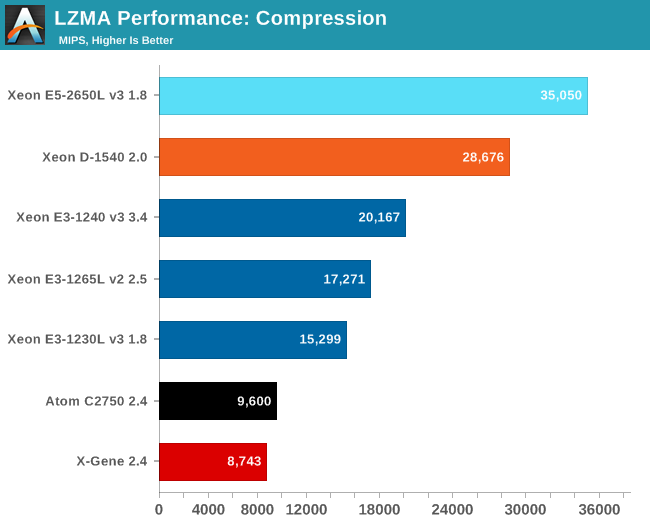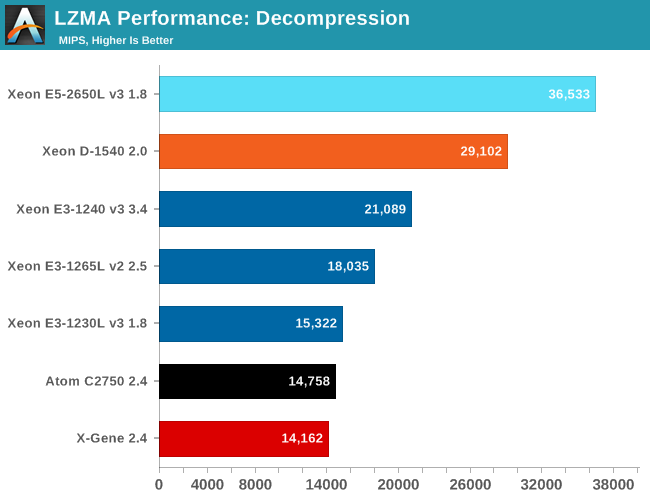The Intel Xeon D Review: Performance Per Watt Server SoC Champion?
by Johan De Gelas on June 23, 2015 8:35 AM EST- Posted in
- CPUs
- Intel
- Xeon-D
- Broadwell-DE
Multi-Threaded Integer Performance
Next we run the same workload in several active instances to see how well the different CPUs scale. The Xeon E5 and Xeon D should finally be able to show off their higher core counts.

The Xeon D scales well: performance is multiplied by 8. It is interesting to note that it delivers 82% of the raw integer processing power of the low power Xeon E5, which has 50% more cores and a 44% higher TDP (65W).
We did not test the Xeon E3-1265L v3 (45 W), but the 3.1 GHz chip will end up between the E3-1265L v2 and E3-1240 v3 (3.4 GHz), it will probably score something like 19000. The Xeon D delivers thus no less than 50% more raw processing power at the same TDP, while integrating more functionality. This should further drive down the total power a server uses. This really shows what an excellent improvement the Xeon D is if you can use the 16 threads.

The decompression benchmark tell us the same story as the compression test: the Xeon D delivers.










90 Comments
View All Comments
Kjella - Tuesday, June 23, 2015 - link
Server on a chip? It's not intended for use with a display, it does all it's "supposed to" do for the hyperscale market without any display.close - Tuesday, June 23, 2015 - link
"Intel was able to combine 8 of them together with dual 10 Gbit, 4 USB 3.0 controllers, 6 SATA 3 controller and quite a bit more".This ^^ makes it a SoC. Ok, a video output would be nice but that certainly doesn't disqualify it.
ats - Tuesday, June 23, 2015 - link
cause video isn't required or even wanted in this market segment. It is a SoC, which simply means system on a chip and doesn't have some ironclad definition. Hell, most "SoC" chips aren't really systems on a chip anyways and require significant supporting logic (this is true for just about any cell phone SoC on the market too).bill.rookard - Tuesday, June 23, 2015 - link
Exactly, you would tend to use remote management over the network to admin this type of a unit. I have several rackmounted servers in my basement (I do some home-serving of websites over a business class connection) and while I do have them actually hooked up to a display, I can hardly remember the last time I looked at them as 99.9% of the time I SSH into everything for administration.About the only time you'd ever really use a display is if you were doing multiple VMs of assorted types. Beyond that, it's wattage wasted.
ats - Tuesday, June 23, 2015 - link
Yeah honestly, having several SM boards with their ILM system, the only time I'd ever hook up a display is if the network was down. The SM ILM will fully proxy pretty much anything you want and give you a 1200p display that works for just about anything. And you can remotely hook up CDs, DVDs, BRs, USB, etc through it along with the stand console and keyboard/mouse functions. Its a very nice solution.nightbringer57 - Tuesday, June 23, 2015 - link
Basically, you don't need video output.Even if you do, mainboard manufacturers usually include a third-party chip with dedicated functions that, along other things, provide a VGA port usable for a server use.
In this case, the AST2400 chip offers some basic GPU functions with a VGA port along with many remote control-related stuff.
Adding all those functions to the Intel SoC would be awfully expensive. The chip only requires a simple PCIe x1 connection from the SoC, but provides hundreds of additional pins. Not only would those functions probably be hard to implement on a relatively recent 14nm process, but it would require at least 300 new pins on the SoC to add all the 3rd party chip's functions on it, which is almost impossible to do.
Th-z - Tuesday, June 23, 2015 - link
There doesn't seem to have a concrete definition for the term SoC, but it's ridiculous now with the term SoC bandwagon. Everything seems to be called "SoC" these days as long as a chip has more than one functions integrated. One of examples is people even called current console's integrated CPU and GPU chip as SoC, which doesn't even have networking and other peripheral units in it. When a system has so many "SoCs" inside, the term really has lost its meaning and significance.redzo - Tuesday, June 23, 2015 - link
I'm thinking this is a bad name for a product like this. It reminds of the infamous Celeron D and Pentium D line.nandnandnand - Tuesday, June 23, 2015 - link
Anyone who can figure out Xeon D exists can probably tell the differencewussupi83 - Tuesday, June 23, 2015 - link
I agree with redzo, I think anyone who can figure out a 'Xeon D' exists AND remembers that Pentium & Celeron D's existed would initially assume this is a budget Xeon - which it's clearly not. E4 sounds pretty logical. But sure lets just put D...